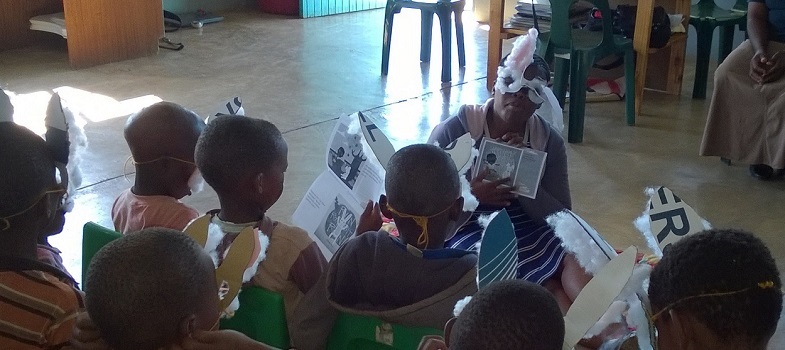Songs and action rhymes for reading
Children come into your classrooms listening and hearing sounds in their environment. This is called phonological awareness.
You can help children to develop this awareness by taking them on a listening walk – into the yard, for example, and asking them to listen out for sounds. What can they hear? You may have cattle in the field next door or community leaders meeting outside the school fence. Maybe there’s a road nearby, or children playing.
Asking children to ‘tune in’ to the different sounds and then – very importantly – asking them to point to where the sound is coming from is a crucial skill in learning to read. Being able to hear different sounds in the environment is the step before being able to break down sounds in words into their smaller parts. It’s also rather fun to go outside on a listening walk. Alternatively, this can be done in the classroom with objects that make sounds, such as a rattle made of bottle tops.
Learning songs and joining in are important foundations for children’s early reading development. Songs and rhymes build children’s internalisation of rhyming strings. The ability to hear and predict rhymes is a predictor of reading ability. Choose songs and rhymes with words that you break down into sounds before building them back up again. Activities like this help children to feel confident in playing with letters and sounds, and supports their understanding of how words are put together.
For example, choose a song or rhyme about a cat. At some point in the rhyme, say ‘CAT’. Then break it down into its three sounds, ‘/C/A/T/’, and then build it back up again to say ‘CAT’. The children can try and say the word all at the same time – this makes it fun and engaging. Try this with other simple words before moving onto words like ‘DUCK’. This is a word with four letters (‘D’, ‘U’, ‘C’, ‘K’) but only three sounds (‘/D/U/CK/’). At this early stage, you want children to learn about the sounds within words. Fun songs and rhymes are a good way to do this.
Something to think about: How many games do you already use in your classroom? How would you explain to a parent who thinks their child is just playing that games like these play an important role in preparing your son or daughter for reading and writing?
Activity 3.8: Using songs and rhymes
Download and/or read a section of a TESSA OER on using songs and rhymes [Tip: hold Ctrl and click a link to open it in a new tab. (Hide tip)] . Share this with your colleagues. Ask them to discuss the case studies and activities in pairs, and then share two reflections or thoughts with the wider group. (Anyone who has a smartphone will be able to access this resource on that.)
Using physical movement to support early reading



